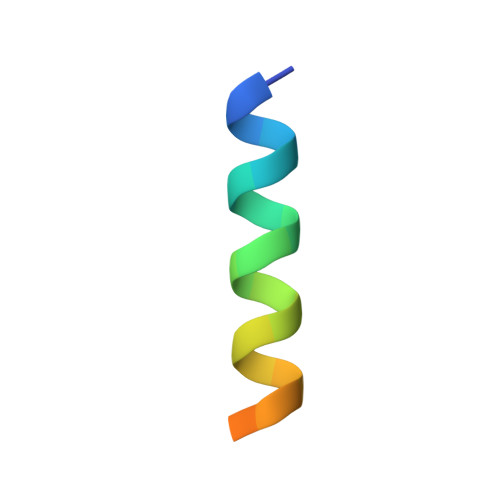Probing initial transient oligomerization events facilitating Huntingtin fibril nucleation at atomic resolution by relaxation-based NMR.
Kotler, S.A., Tugarinov, V., Schmidt, T., Ceccon, A., Libich, D.S., Ghirlando, R., Schwieters, C.D., Clore, G.M.(2019) Proc Natl Acad Sci U S A 116: 3562-3571
- PubMed: 30808748
- DOI: https://doi.org/10.1073/pnas.1821216116
- Primary Citation of Related Structures:
6N8C - PubMed Abstract:
The N-terminal region of the huntingtin protein, encoded by exon-1, comprises an amphiphilic domain (htt NT ), a polyglutamine (Q n ) tract, and a proline-rich sequence. Polyglutamine expansion results in an aggregation-prone protein responsible for Huntington's disease. Here, we study the earliest events involved in oligomerization of a minimalistic construct, htt NT Q 7 , which remains largely monomeric over a sufficiently long period of time to permit detailed quantitative NMR analysis of the kinetics and structure of sparsely populated [Formula: see text] oligomeric states, yet still eventually forms fibrils. Global fitting of concentration-dependent relaxation dispersion, transverse relaxation in the rotating frame, and exchange-induced chemical shift data reveals a bifurcated assembly mechanism in which the NMR observable monomeric species either self-associates to form a productive dimer (τ ex ∼ 30 μs, K diss ∼ 0.1 M) that goes on to form a tetramer ([Formula: see text] μs; K diss ∼ 22 μM), or exchanges with a "nonproductive" dimer that does not oligomerize further (τ ex ∼ 400 μs; K diss ∼ 0.3 M). The excited state backbone chemical shifts are indicative of a contiguous helix (residues 3-17) in the productive dimer/tetramer, with only partial helical character in the nonproductive dimer. A structural model of the productive dimer/tetramer was obtained by simulated annealing driven by intermolecular paramagnetic relaxation enhancement data. The tetramer comprises a D 2 symmetric dimer of dimers with largely hydrophobic packing between the helical subunits. The structural model, validated by EPR distance measurements, illuminates the role of the htt NT domain in the earliest stages of prenucleation and oligomerization, before fibril formation.
Organizational Affiliation:
Laboratory of Chemical Physics, National Institute of Diabetes and Digestive and Kidney Diseases, National Institutes of Health, Bethesda, MD 20892-0520.














